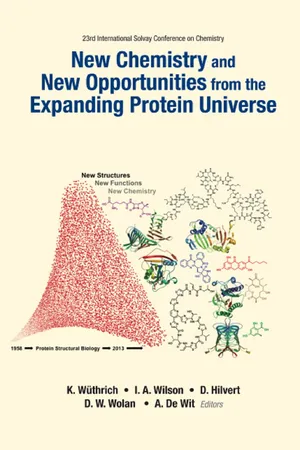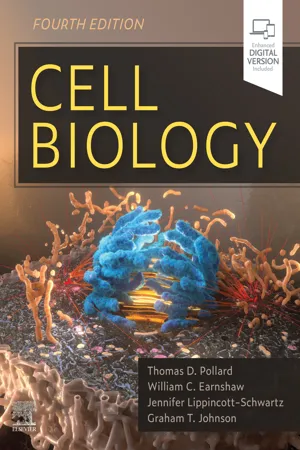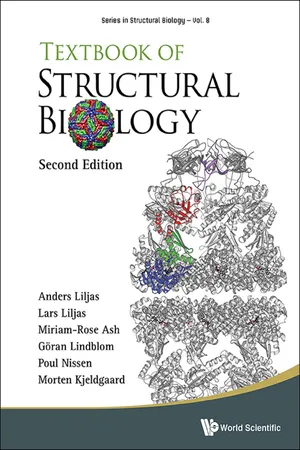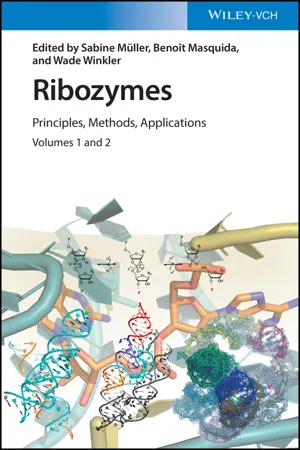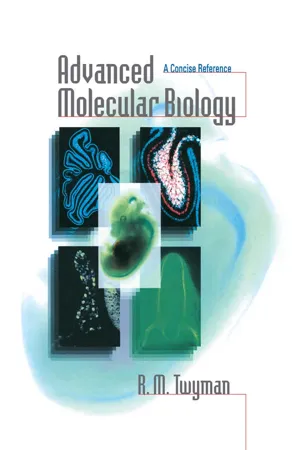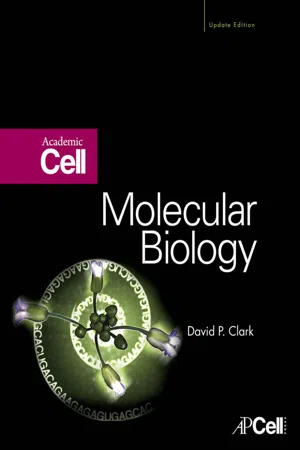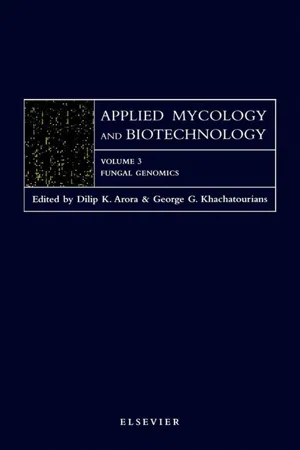Biological Sciences
Ribosomes
Ribosomes are cellular structures responsible for protein synthesis. They are composed of RNA and protein and can be found in the cytoplasm or attached to the endoplasmic reticulum. Ribosomes read the genetic information from messenger RNA and use it to assemble amino acids into proteins through a process called translation.
Written by Perlego with AI-assistance
Related key terms
8 Key excerpts on "Ribosomes"
- eBook - ePub
New Chemistry and New Opportunities from the Expanding Protein Universe
Proceedings of the 23rd International Solvay Conference on Chemistry
- Kurt Wüthrich, Ian A Wilson, Donald Hilvert, Dennis W Wolan, Anne De Wit(Authors)
- 2014(Publication Date)
- WSPC(Publisher)
These developments are now propelling the studies of large macromolecular assemblies to a new level and several new structures have emerged in the past few years that reveal interesting architectural features of protein components in large cellular complexes and their functional roles, for some examples see: [ 1, 4 – 7 ]. The section below outlines our contributions to the field using as an example our structural studies of eukaryotic Ribosomes, multi-megadalton ribonucleoprotein complexes responsible for protein synthesis. Recent research contributions (proteins in supramolecular machines) The ribosome is a large cellular assembly that plays a central role in the process of protein synthesis in all organisms [ 8 ]. Although basic aspects of protein synthesis are preserved in all kingdoms of life, eukaryotic Ribosomes are much more complex than their bacterial counterparts, require a large number of assembly and maturation factors during their biogenesis, use numerous initiation factors, and are subjected to extensive regulation [ 9, 10 ]. Recently we obtained detailed structural information on eukaryotic Ribosomes by determining the first complete structures of both eukaryotic ribosomal subunits each in complex with an initiation factor [ 9, 11 ]. These results are of fundamental importance for understanding protein synthesis in eukaryotes and are the prerequisite for understanding the structural basis of the regulation of protein synthesis in normal cells and how it is perturbed in various diseases. Crystal structure of the eukaryotic 40S ribosomal subunit in complex with initiation factors 1 and 1A The eukaryotic 40S ribosomal subunit plays a central role in the initiation of protein synthesis during which it interacts with more than a dozen eukaryotic translation initiation factors (three in bacteria) [ 12 ] - eBook - ePub
- Thomas D. Pollard, William C. Earnshaw, Jennifer Lippincott-Schwartz, Graham Johnson(Authors)
- 2022(Publication Date)
- Elsevier(Publisher)
Assembly factors consisting of snoRNAs and numerous proteins then orchestrate the stepwise assembly of rRNAs and ribosomal proteins into the small and large subunits and guide their export from the nucleus into the cytoplasm. Ribosomes are stable for days, but starving cells may use them as a source of nutrients, after selection by autophagy and delivery to lysosomes for degradation (see Fig. 24.9). Although the genes for many ribosomal proteins are essential for viability, mutations in some cause remarkably specific defects. For example, humans with just one functional gene for ribosomal protein RPSA are missing their spleen but are otherwise normal. Mutations in genes for other subunits cause anemia and mutations in genes for certain assembly proteins cause liver disease. One explanation for these defects in specific organs is that translation of particular mRNAs in specialized cells may be sensitive to the concentration or total activity of Ribosomes. Mechanism of Protein Synthesis Organisms in all three domains of life use homologous components and similar biochemical reactions catalyzed by Ribosomes to synthesize proteins in four steps: initiation, elongation, termination, and subunit recycling (Fig. 12.1). Conformational changes move a ribosome along a mRNA as the gene sequence is read out. Ribosomes make few errors thanks to precise pairing between mRNA codons and tRNAs with their amino acids and to guanosine triphosphatase (GTPase) proteins that regulate the fidelity of each step (see Fig. 4.6 for details on GTPase cycles). As expected after 3 billion years of evolutionary divergence, some details differ across the phylogenetic tree. Initiation Phase The goal of initiation is to bring together an initiator tRNA carrying methionine (or N -formylmethionine, fMet, in Bacteria) and the AUG initiator codon of a mRNA on the ribosome ready for elongation of the polypeptide (Fig. 12.8) - eBook - ePub
- Anders Liljas, Lars Liljas;Miriam-Rose Ash;G?ran Lindblom;Poul Nissen;Morten Kjeldgaard(Authors)
- 2016(Publication Date)
- WSPC(Publisher)
11Protein Synthesis â Translation
11.1Evolution of the Translation System
The translation of genetic information into functional protein molecules is a central process for life; and the genetic code, tRNA molecules and the machinery for protein synthesis are all highly conserved. The ribosome on which translation occurs is composed of protein and rRNA molecules. Carl Woese showed that sequenced fragments of ribosomal rRNA molecules from a large variety of species were related. Thus, the ribosomal RNAs could be used to analyze the relationship between species. By 1977, he could show that it was not correct to divide the present living organisms into prokaryotes and eukaryotes. A unique new kingdom had to be introduced: archaea. Living organisms, according to Woese, had to be organized into bacteria, archaea and eukaryotes.In comparisons of completely sequenced genomes, the molecules of the translation apparatus stand out as dominating the group of universally conserved molecules. The genetic code, tRNAs, ribosomal rRNA, ribosomal proteins and translation factors must have coevolved at a very early phase of biological evolution and have subsequently gone through only limited further changes.An important aspect of protein synthesis is that nucleic acid molecules have central roles, in contrast to most other processes in cells where proteins dominate. Central components are the mRNA, the tRNA and the ribosomal rRNA molecules. An mRNA molecule contains a copy of the gene sequence and binds to the ribosome. The tRNA molecules, the adapters suggested by Francis Crick, decode the gene sequence and link the amino acid into the growing peptide on the ribosome.Fig. 11.1 ▪ - eBook - ePub
Ribozymes
Principles, Methods, Applications
- Sabine Müller, Benoît Masquida, Wade Winkler, Sabine Müller, Benoît Masquida, Wade Winkler(Authors)
- 2021(Publication Date)
- Wiley-VCH(Publisher)
8 The Ribosome and Protein SynthesisPaul HuterMichael Graf and Daniel N. WilsonUniversity of Hamburg, Institute for Biochemistry and Molecular Biology,, 20146 Hamburg, Germany8.1 Central Dogma of Molecular Biology
Conservation of the genome, its transfer, and faithful implementation of the information stored within are fundamentally important steps in every cell. About 50–60 years ago, the central dogma of molecular biology gained prominence for establishing the sequential occurrence of these vital events and their interconnectedness [1 , 2 ]. The classical view describes a consecutive order of events, in which deoxyribonucleic acid (DNA ) can either replicate itself to maintain the genomic integrity (replication) or transfer its information into ribonucleic acid (RNA ) molecules (transcription), which in turn serve as templates for the synthesis of proteins (translation). Together, replication, transcription, and translation form the three founding pillars of the dogma of molecular biology. This model is valid to this day; however, extensive studies over the past decades have broadened our understanding of the molecular mechanisms behind it. Both replication and transcription require the recruitment of macromolecular machines. While replication of the genome requires the action of DNA polymerases, transcription of information from DNA to RNA is mediated by RNA polymerases. RNA molecules are a heterogeneous population that fulfill various roles in a cell and can be divided into two major classes, namely, noncoding RNA (ncRNA ) and messenger RNA (mRNA ). Recent studies have shown that ncRNAs pursue different functions such as catalysis of chemical reactions (e.g. ribosomal RNA [rRNA ]), serving as adaptor molecules (e.g. transfer RNA [tRNA ]) or structural scaffolds (e.g. rRNA) and regulating gene expression (e.g. micro RNA [miRNA ]) [3 , 4 ]. On the other hand, mRNAs contain the information of genes, which can be decoded and translated into proteins. This process is called translation and is mediated by Ribosomes. In contrast to the other two molecular machines, the ribosome consists predominantly of rRNA, and the structural and mechanistic themes of the core components are conserved among the three phylogenetic kingdoms of life. However, there are certain differences between, and as well as within, each kingdom concerning size, regulation, and composition, to name but a few [5 , 6 ]. Here we focus exclusively on the prokaryotic ribosomal machinery of Escherichia coli. Unless mentioned otherwise, all Ribosomes within this chapter refer to the E. coli - eBook - ePub
Advanced Molecular Biology
A Concise Reference
- Richard Twyman(Author)
- 2018(Publication Date)
- Garland Science(Publisher)
attenuation, retroregulation). Conversely, in eukaryotes there is a considerable delay between transcription and translation while the mRNA is first processed and then exported from the nucleus. Both of these events are potential targets for regulation.Ribosomes. Ribosomes are large, abundant ribonucleoprotein complexes upon which protein synthesis occurs. They are found free in the cytoplasm and, in eukaryotes, associated with the membrane of the rough endoplasmic reticulum. Ribosomes may function alone (monosomes) although it is common to see them in clusters concurrently translating the same mRNA (polysomes). Polysomes can be extracted from cells and used to purify mRNA (q.v. poly(A)+ RNA).All Ribosomes comprise two dissimilar sized subunits, the large and small subunits. Each sub-unit consists of several ribosomal RNAs (rRNAs) and numerous ribosomal proteins (r-proteins). Their relative sizes are often expressed in Svedberg units (Box 23.1 ). In E. coli, the 70S ribosome is composed of a small 30S subunit and a large 50S subunit. The small subunit contains 21 different proteins (named S1–S21), and the 16S rRNA. The large subunit comprises 34 proteins (named L1–L34) and the 23S and 5S rRNAs. Some proteins are common to both subunits (e.g. L6 = S20). Eukaryote Ribosomes are larger (80S) and contain more components. The small (40S) subunit comprises 33 proteins and the 18S rRNA whilst the large (60S) subunit contains 50 proteins and three rRNAs of 28S, 5.8S and 5S. The 5.8S rRNA is homologous to the 5′ portion of the bacterial 23S rRNA and forms complementary pairs with the equivalent eukaryotic 28S rRNA. Archaen Ribosomes resemble those of bacteria, but some genera contain extra subunits similar to those of eukaryotes.The spatial organization of the ribosome is complex. rRNA makes up 60–65% of the total mass and is essential for structural integrity and function, adopting complex tertiary and quaternary conformations by intra- and intermolecular base pairing. The manner in which proteins interact with the RNA and each other within this network has been studied in great detail for the E. coli - eBook - ePub
- David P. Clark(Author)
- 2009(Publication Date)
- Academic Cell(Publisher)
The decoding process is carried out by a submicroscopic machine called a ribosome that binds mRNA and charged tRNA molecules. The mRNA is translated, starting at the 5′-end. After binding to the mRNA, the ribosome moves along it, adding a new amino acid to the growing polypeptide chain each time it reads a codon. Each codon on the mRNA is actually read by an anticodon on the corresponding tRNA and so the information in the mRNA is used to synthesize a polypeptide chain from the amino acids carried by the tRNAs.Ribosomes consist of proteins plus RNA and their role is to synthesize new proteins.The ribosome and its components were originally analyzed by ultracentrifugation. Consequently, sizes are referred to in Svedberg units (S-value), which measure sedimentation velocity. Although higher S-values indicate larger particles, the S-value is not directly proportional to molecular weight. The bacterial (70S) ribosome consists of two subunits, the 50S or large subunit and the 30S or small subunit (Fig. 8.08 ). Eukaryotic (80S) Ribosomes are somewhat larger, consisting of 60S and 40S subunits (see below).Figure 8.08 Components of a Bacterial RibosomeThe ribosome is composed of 30S and 50S subunits. These in turn are composed of ribosomal RNA and numerous proteins. The 30S subunit is built from 16S rRNA together with 21 proteins. The 50S subunit contains 5S and 23S ribosomal RNA plus 34 proteins.The bacterial ribosome contains three ribosomal RNA molecules that make up about two thirds of its weight and about 50 smallish proteins that make up the remaining third. The 30S subunit contains the 16S rRNA and the 50S subunit contains the 5S and 23S rRNA (Fig. 8.08 ). The 3-D structure of a 70S ribosome is shown in Figs. 8.09 and 8.10 .Figure 8.09 3-D Structure of a Ribosome by EMThis structure was deduced from negatively stained electron microscope images of a bacterial 70S ribosome.Figure 8.10 3-D Structure of a Ribosome by X-RayViews of the structure of the Thermus thermophilus - eBook - ePub
- (Author)
- 2003(Publication Date)
- Elsevier Science(Publisher)
8Ribosome Biogenesis in Yeast: rRNA Processing and Quality Control
Ross N. Nazar [email protected] Department of Molecular Biology and Genetics, University of Guelph, Guelph, Ontario, Canada N1G 2W1.The ribosome, being a cell’s factory for protein synthesis, represents a cellular substructure that is critical, both for cell growth and survival. In the eukaryotes, the cytoplasmic ribosome is synthesized, almost exclusively, in a specialized subnuclear compartment called the nucleolus. Biogenesis begins with the transcription of rRNA precursors (pre-rRNAs) from rRNA genes (rDNA) that are localized in the nucleolus and ends with the transport of pre-ribosomal subunits to the cytoplasm where the final steps in the maturation process occur. In the course of ribosome biogenesis, the pre-rRNAs are cleaved and covalently modified while assembling with ribosomal proteins to form the mature subunits. These assembly and maturation processes are dependent on both cis-acting elements and many non-ribosomal protein or RNA trans-acting factors. The mature ribosome is the result of numerous macromolecule interactions involving many RNA and protein molecules which are actual ribosomal constituents and other molecules which ultimately are excluded from the mature particle. Together, the maturation processes provide a cell, and perhaps biotechnologists, with a means to control cell growth and even a mechanism for quality control.1 INTRODUCTION
A great variety of genetic and biochemical approaches has been used extensively to study ribosome biogenesis over a 40 year period. In general, the maturation of the pre-rRNA and the basic processes in the biogenesis of the ribosomal subunits appear to be largely conserved among the eukaryotes, but differences in many species-specific details also have been reported. In all the organisms that have been examined, the nascent pre-rRNA is first assembled into an 80-90S nucleolar particle. Structural rearrangements and nucleotide modifications occur as the ribosomal proteins are recruited, followed with cleavages which ultimately result in the mature cytoplasmic 40S and 60S ribosomal subunits. Since yeasts can be manipulated easily both genetically and biochemically, a majority of these studies has occurred in yeast cells, initially in Sacharomyces cerevisiae (Grivell and Planta, 1990 ) but, more recently, also in Schizosacharomyces pombe - Naoki Sugimoto(Author)
- 2021(Publication Date)
- Wiley-VCH(Publisher)
Figure 7.4 ). Ribosome can be separated into two subunits (50S large subunit and 30S small subunit in prokaryotes and 60S large subunit and 40S small subunit in eukaryotes). Most of the ribosomal mass and inner surface, which binds mRNA and tRNA, is represented by rRNAs. Especially, the active site of the ribosome for the polymerization of amino acids is surrounded by 16S or 18S rRNA, and the rRNA functions to catalyze the polymerization of amino acids.Structure and composition of ribosome. Ribosome consists of large and small ribosomal subunits. Each subunit contains ribosomal RNAs (rRNAs) and ribosomal proteins. Structures of the larger and small ribosomal subunits and its complex (mature ribosome) are those derived from Escherichia coli (PDB ID: 5MDZ). Ribosomal RNAs are shown in gray. Ribosomal proteins for the large and small subunits are shown by space-filling model. Structure of mRNA pathway on the surface of small subunit is derived from Thermus thermophilus ribosome (PDB ID: 4V4P). In the image, mRNA on the small subunit is emphasized dark. Front side of the structure is clipped at the place of mRNA pathway.Figure 7.47.3 General Process of Translation
The process of translation reaction is generally divided to three steps, which are initiation, elongation, and termination.7.3.1 Translation Initiation
Translation starts from interaction of the small ribosomal subunit and mRNA. The beachhead of the ribosome binding on the mRNA is different between eukaryote and prokaryote. In the case of eukaryotes, mRNAs have a 7-methylguanylate (m7G) cap structure (5′ cap) at its 5′ end (Figure 7.5a ). Several eukaryotic initiation factors (eIFs) in eIF4 group recognize 5′ cap structure and recruit small ribosomal subunit on the mRNA. In the case of prokaryote, the small ribosomal subunit recognizes a conserved ribosomal binding site (RBS), which is also known as Shine-Dalgarno sequence, on mRNA (Figure 7.5b ). The sequence of RBS is purine rich and has complementarity to 3′ end of prokaryote 16S rRNA that enables direct interaction through base pairing. In both prokaryotes and eukaryotes, when the small ribosomal subunit interacts with mRNA, initiator tRNA is already located on a peptidyl-tRNA binding site (P-site) of the small ribosomal subunit with the aid of the initiation factor proteins. The initiator tRNA is generally attaching methionine (in eukaryote) or formylmethionine (in prokaryote). The anticodon sequence of the initiator tRNA is CAU, which base pairs with AUG start codon. After the binding to the mRNA, the small ribosomal subunit finds initiation codon. In prokaryotes, the initiation codon is generally located close downstream of the RBS. In eukaryotes, the small ribosomal subunit moves according to mRNA until the initiation codon (Figure 7.5a
Index pages curate the most relevant extracts from our library of academic textbooks. They’ve been created using an in-house natural language model (NLM), each adding context and meaning to key research topics.
